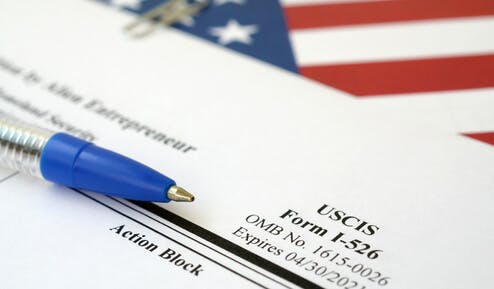In the latest episode of podcast series eb5superheroes, Matt Trusch interviews Rupy Cheema of EB5 Diligence. She explains that even though every EB-5 offering is structured by immigration and securities professionals they do not represent the investor. She sees the role of due diligence as reviewing the offering from the investor’s perspective and highlighting issues they should be aware of before making an investment decision. Also, it’s important to note that due diligence is a holistic process that doesn’t just rely on quantitative and document analysis.“We bring the investor’s perspective on it,” she explains. "My job is to bring transparency. I think the investor should understand what they’re buying into. They should understand their rights and remedies. And they should know all the strengths and risks of the deal. That’s what we bring to the table: what an investor should know before making that decision.”
How EB-5 Diligence services have evolved
When EB5 Diligence was launched around 2013, the investors were mainly coming from China and investments were mostly sold through migration agents. There wasn’t much demand for due diligence at the time from that market. Investors trusted the migration agents to present good projects.Now India drives the lion’s share of EB-5 demand. But that market, especially high-net-worth individuals, do not rely on migration agents because of fraud that has been associated with agents. So instead, Indian investors themselves look for an independent review of the projects they are considering. “They tend to go online and do a lot of their own research,” Cheema observes.
The due diligence checklist has changed with the rise of direct investments
The aim of due diligence is to determine the likelihood of USCIS approval and the full return of capital. When regional center investments dominated the EB-5 market, the due diligence checklist was designed for mainly commercial real estate projects. But the expiry of that program and the emergence of direct investments has changed the due diligence process. “The industry has shifted from being mainly a real estate financing vehicle to a variety of offerings: manufacturing, Telehealth, call centers, all sorts of businesses — and businesses with a history which must be evaluated, whereas a new construction project didn’t have operating history,” states Cheema
A holistic approach to due diligence: documents aren’t enough
Due diligence requires a holistic approach. Site visits, for example, have provided invaluable insight that documents just don’t offer. A site visit provides insight into many factors such as suitability of the location, progress made to date, and the ability of management to execute on the business plan and meet investors’s goals.The qualitative review can apply to a business’ management —and how they handle due diligence enquiries. “Are they very open and transparent? Or do they put up roadblocks? So it’s more than just a quantitive assessment,” declares Cheema.
Can EB-5 projects be rated side by side?
In the Regional Center Program, the offerings were structured in a uniform manner and most were in the commercial real estate industry which made comparing and rating projects easier. Direct investments span many industries and can be structured very differently, therefore a strength and risk analysis is more informative than a score.
With the Regional Center Program lapse, is the industry still busy?
In short, yes. There’s significant investor interest at the $500,000 level.Further, many businesses that couldn’t compete with the Regional Center Program — because of the investor perception of the safety of real estate — now can now raise money at the $500,000 level.
Was the regional center loan model safer than equity direct investments?
Cheema points out that the debt model had risks. Regional center investors are equity holders in the new commercial enterprise — and were thus subject to the Manager’s decision on when they would be liquidated. Further, those investors had to deal with the uncertainty of early repayment and the subsequent redeployment, not knowing where the money was going to end up.But she acknowledges that a loan model made many investors feel safer. “Having a term gave people comfort that five or seven years down the road the money is going to be repaid — it might be redeployed — but the borrower is obliged to repay the new commercial enterprise.”
Different direct opportunities — and incentives to repay investors after I-829 approval
While making an equity investment is the essence of the program, Cheema states that with direct investments, “every deal is going to have a different possibility, a different opportunity. Some are raising money where the investors have an equal opportunity alongside other common equity holders; they can participate in the upside as much as other common equity holders.”Alternatively, she’s also seeing where investments offer a preferred dividend, and once the investors have their I-829 approval, the issuer obligation escalates so that it becomes much more expensive to retain that EB-5 capital. “There are ways to structure it where the management is incented to exit the EB-5 investors.”
Do job-counting differences make one program is preferable?
With the Regional Center Program, Cheema does see some benefit to counting construction jobs because the ”money just has to be spent,” she says. But one has to evaluate whether all financing will be available, entitlements are in place, the budget is not going to increase, and other construction risks are managed. Also, construction projects can often face delays for an array of reasons which can threaten job creation, so one can not take construction jobs for granted.A similar evaluation can be applied to likelihood of creation of operational jobs such as availability of financing, and management’s ability to execute on the business plan.
How long do direct jobs have to be sustained?
The jobs must be created as full-time and permanent. But there is no prescribed amount of time that these jobs must last in order for USCIS to approve a petition. “Things shift and businesses close or fail and you can still be able to get credit for creating those full-time jobs,” states Cheema.
Does USCIS or Congress need to promote transparency in EB-5?
Given that EB5 Diligence has an agnostic approach to due diligence and is driven by transparency, does Rupy believe that program regulations or even legislation needs to promote greater transparency in the industry? Yes, she does.The integrity measures in the Grassley and Leahy bill were very important, she believes, because when you sell private placements in the U.S. to US investors, you must follow securities laws. Broker-dealers have an obligation to do a certain level of due diligence. But when you are able to sell these investments offshore through migration agents who are not registered, you can avoid following the securities rules.“I don’t think that selling to non-U.S. investors should be any different than selling to U.S. investors,” she declares. I think integrity measures are very important — that the same level of due diligence you provide to U.S. investors should be provided to non-U.S. investors.”
Verifying the facts
Due diligence should ensure sure every claim being made in the offering memorandum is true, that it’s backed up by actual agreements.Securities attorneys are drafting the private placement memorandum (PPM) based on the information given to them. The business plan writer is relying on the developer’s numbers. The developer will say they’re relying on market analysis. Everyone is pointing to the next person. Thus, it is very common to see inconsistencies among different documents. “Calculation errors are more common than you think,” Cheema says. As an example, her firm was once looking at a large hotel development in Manhattan. They had a feasibility study conducted by a reputable valuation company that does thousands of these studies — and they had a calculation error that led to the hotel being overvalued by over $100 million.In addition to verifying facts, her due diligence review can result in pointing out issues to the securities attorney which will lead to certain disclosures being added to the PPM. So due diligence can catch things that other experts sometimes miss.
What will happen with the Regional Center Program — and direct investments?
Being a professional rooted in facts, Rupy doesn’t want to speculate on the future of regional center investments. “Like everybody else, I only know what I hear,” she states.But her familiarity with direct investments makes her very optimistic about their popularity going forward. “Direct investments are here to stay. Simply because there are more options for investors.”Also, Indian investors would balk at a 0.5% return. “So now directs can compete well with regional center investments.”
Direct investments can include a substantial raise of EB-5 funds for a growing business
There was a long-held assumption in the industry that a direct investment was only feasible for an owner-operated business like a franchise restaurant. That’s not the case anymore.Cheema is seeing established growth-stage businesses in myriad sectors seek out direct EB-5 capital. “I’m reviewing direct investments that are looking to raise anywhere from $2 million to $20 in EB-5 capital because they’re creating enough jobs.”
With a big investment differential, direct investments may have an advantage
One of the challenges for regional center projects, Cheema observes, is if there is a big cost differential between a TEA and non-TEA investment; a wide margin may give direct investments an advantage over regional center projects.History has proven that the vast majority of investors choose to invest at the lower investment level. And most regional center projects are dependent on certain big urban markets that may not qualify for TEA status. As a counterpoint, many direct investments, such as manufacturing or tele-health services, can choose their site of business, and are thus more capable of qualifying for the lower investment threshold.
From a due diligence perspective, which program has more impact to the U.S. economy?
“I think it’s been very beneficial to the U.S. economy,” says Cheema. “There’s a debate, obviously about rural vs. urban — what’s having more impact? Developers who are raising money and would’ve raised this money anyway? Or smaller businesses outside of commercial real estate?”
Summary: more and more investors seek due diligence
More and more people, especially outside of China, are looking for due diligence before making an EB-5 investment. They are doing research online about EB-5 and see the failure stories and realize that due diligence is necessary.“I’m optimistic because due diligence is in demand. For me, it doesn’t matter if it’s a regional center or direct investment. There is a permanent program. The pilot program is on hold but we still have an EB-5 program.”
Interested in working with the expertise of EB5 Diligence?
If you’re interested in due diligence for EB-5 investments, there are two ways to access the reports of EB5 Diligence: 1. eb5Marketplace.com features many investment options all with the due diligence of EB5 Diligence — and is free to use.2. An investor can select their own investment to be reviewed by EB5 Diligence.Listen to the Matt Trusch EB5 Superheroes podcast #8: Rupy Cheema, CEO and Founder of EB5 Diligence



